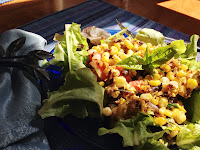by Maria Noël Groves, Clinical Herbalist & Co-op Wellness Educator
What you eat can have a huge impact on your health, for better or for worse. Overhauling your diet sounds insurmountable and depressing, not to mention confusing with all the conflicting information out there! Let’s break it down into six simple steps and share ways to learn to love food *even more* while also making better decisions.
1. Fall in Love with Fruit & Vegetables: Aim for five servings a day minimum and nine servings for optimal health. They’re low-calorie and loaded with important vitamins, minerals, antioxidants, anti-inflammatory compounds, and other amazing phytonutrients. This is the single most important thing you can do for your health with your diet, yet only a quarter of Americans even eat three servings daily (and that’s counting lettuce and tomato on a burger as “a serving”). It CAN be done! Salads, soups, fresh-made mostly vegetable juices, and produce-loaded stir fries can easily incorporate several servings in one dish. Turn to produce for snacks. The deeper and greater variety of color the better. When using vegetables in a recipe, use the whole bunch and polish it off – fill at least half your plate with ‘em!
2. Focus on Whole Foods: Packaged foods (even “healthy” packaged foods) are usually expensive and devoid of nutrient content. Discover truly whole foods – besides produce, this includes whole grains, beans, mushrooms, seeds, nuts, olive oil. Visit the bulk section and take home a small amount of a new item each week to try out in a recipe and learn what you like. This kind of diet is generally low-glycemic and rich in good fats – perfect for blood sugar, heart health, and mood. It’s also all-natural and even better if it’s organic. If you must have something packaged, look for whole foods ingredients and ONLY natural ingredients – hydrogenated oils, preservatives, flavorings, artificial sweeteners etc. are usually carcinogenic, bad for heart health, and can negatively effect pain, inflammation, and mood.
3. Opt for Animals that Live & Eat Well (& Eat them in Moderation): Meat, dairy, fish, and eggs are indeed whole foods and good sources of protein, fats (great source of omega 3s!), and nutrients (B vitamins, vitamin D…) IF they are raised properly. We are what the animals eat and how they live. Choose wild or grass-fed, sustainably farmed, free-range, and/or organic options. If it comes from a local farm that allows the animals to pasture and feeds them clean food, that’s best. It’s significantly more expensive than the factory farmed counterparts, so offset this by focusing on steps #1 and 2 – increase your vegetarian options and use smaller cuts of meat. Eggs are a great and economical protein source if you tolerate them. Want proof that quality matters? Compared to a factory farmed egg, a pasture egg has up to 4 times the vitamin D, 2/3 more vitamin A, 7 times more beta carotene, 3 times more vitamin E, 2 times more omega 3s, 1/3 less cholesterol, and 1/4 less saturated fat. Eating 3 servings of grass-fed meat per week upped blood levels of omega 3s to levels comparable to someone taking a fish oil supplement.
4. Drink Wisely: Many beverages are just a delivery mechanism for sugar, fat, calories, and not much else. Stick to water, tea (with green tea offering tremendous health benefits), and seltzer with natural flavors – your wallet will thank you, too. In moderation, wine/beer, fresh juices, smoothies, milk, coffee, and quality cocoa also have health benefits, but the calories add up quickly, and they are expensive.
5. Balance Your Meals: We need carbs, fat, and protein, what’s called macronutrients (even though we usually get too much of them and too few of micronutrients like vitamins, minerals, antioxidants). Get the most of out your meals and curb cravings by being sure to have some quality carbs, fat, and protein at every meal and snack. This helps keep blood sugar stable and maintains a better mood.
6. Listen to Your Body: Are you eating too much (stuffed!) or too little (starving!)? Are you sensitive to gluten, dairy, eggs, or soy? Get in the habit of checking in with your body after you eat and day to day. We’re not talking about taste and cravings. How do you REALLY feel? Some effects are immediate, others will take place over several days. Try switching things up in your diet and see how you feel again. Give your body a few days to a week to adjust to new things, especially cutting sugar/carbs, increasing fiber with whole foods, and eating lots more produce.
Ok, so maybe I have a few more things to say about this…Stay Positive & Get Inspired by Good Food: We need to eat to live, but we can still enjoy it! Healthy food is delicious, too! See my
Get Inspired blog post for tips, recipe resources, great cookbooks, and more. Don’t let the Food Guilt Police get to you! We don’t need to fear our food choices.
Localvore Mindset: There is no guilt in an avocado or some fresh citrus from Florida, but eating local, in-season food is generally fresher, better tasting, more nutritious, sometimes less expensive, and of course supports local farmers that you can actually meet and see how the farm is run. Seek out farmers markets, CSAs (you prebuy a share and get regular deliveries), and farm stands (just beware those whoopie pies! Well maybe once in a while they’re not so bad…). However, you can't beat the convenience of the Co-op's selection of thousands of local and regional products available all day, seven days a week. Even in the depths of winter I can stock up on local potatoes, carrots, onions, and more.
Click here for a bunch of resources.
Make Your Own Meals: This is the easiest, cheapest way to eat healthy, and it’s really enjoyable once you get the hang of it. The meals can be as complicated or simple as you want. Need recipes?
www.eatingwell.com and its corresponding email list, magazine, and cookbooks (I love them all!) is a great place to start. Pay attention to star ratings and ease/time frame for prep. Another latest favorite is the
Sprouted Kitchen blog and cookbook.
Healthier Convenience: When you want something a little healthier on the go, you do have some good options. The Concord Co-op is one of the best and very reasonably priced (I'll admit, I'm biased, but they really are great!), Spoon Revolution has well-priced vegan and gluten-free fare. Republic in Manchester, Lemon Grass in Moultonborough, and Libby’s Bistro/Saalt Pub are some more extravagant choices for a nice night out.
Won’t This Cost a Lot? Packaged food and eating out is expensive. Eating healthy doesn’t have to be. Focus on whole foods like grains and beans, vegetables (especially greens), vegetarian and meat-light meals, and in-season produce. Seek out pick-your-own farms, CSAs, meat shares, and other opportunities to buy direct from farmers. I can supply my family of two with almost all of our meals for just $60-100 each week, serving up almost 100% local, natural, and organic fare, mostly from the Co-op. If organic seems too expensive, it’s ok. Pesticides aren’t good for us (in fact, they’re pretty terrible, and in combination with other chemicals in our food become a daily low-dose synergistically toxic soup), but it’s better to eat conventional strawberries than to not eat them at all or to eat processed food instead. That's not just my opinion; there’s research to prove it!
Click here for more info on what's best organic.
What about Supplements? Supplements are handy, and it’s true that we have depleted the nutrients in our soil so that our food is actually not as nutritious as it once was. (Even more reason to support local, organic, sustainable, and biodynamic farmers who build the soil back up!) But, supplements can’t replace a good diet and are expensive. I’d rather you spend your money on good food! Micronutrients work better with biodiversity, which food and a varied healthy diet will give you. For example, in one study lycopene reduced tumors by 18%, powdered tomato (34%), powdered broccoli (42%), combined tomato and broccoli (52%). Let the synergy of real food work for you and think of supplements as back up and to address specific concerns.
 For crackers, choose a mix of gourmet and tried-and-true styles. Locally
made Craquelins crisps are always amazingly delicious and gorgeous on
the table. Standard fare crackers help fill the gaps - Kashi and Back to
Nature have a wide range of great options, and sometimes you can catch
them on sale this time of year. My personal faves include the Harvest
Whole Wheat Crackers and the Sesame Tarragon, which are fancy without
offending bland taste buds.
For crackers, choose a mix of gourmet and tried-and-true styles. Locally
made Craquelins crisps are always amazingly delicious and gorgeous on
the table. Standard fare crackers help fill the gaps - Kashi and Back to
Nature have a wide range of great options, and sometimes you can catch
them on sale this time of year. My personal faves include the Harvest
Whole Wheat Crackers and the Sesame Tarragon, which are fancy without
offending bland taste buds. After you put out your spread, give yourself a treat! Heidi recommends her favorite holiday treat: Drinking Moonlight Meadery's Kurt's Apple Pie with some Grafton Cellars Naked Cheddar.
After you put out your spread, give yourself a treat! Heidi recommends her favorite holiday treat: Drinking Moonlight Meadery's Kurt's Apple Pie with some Grafton Cellars Naked Cheddar.








































